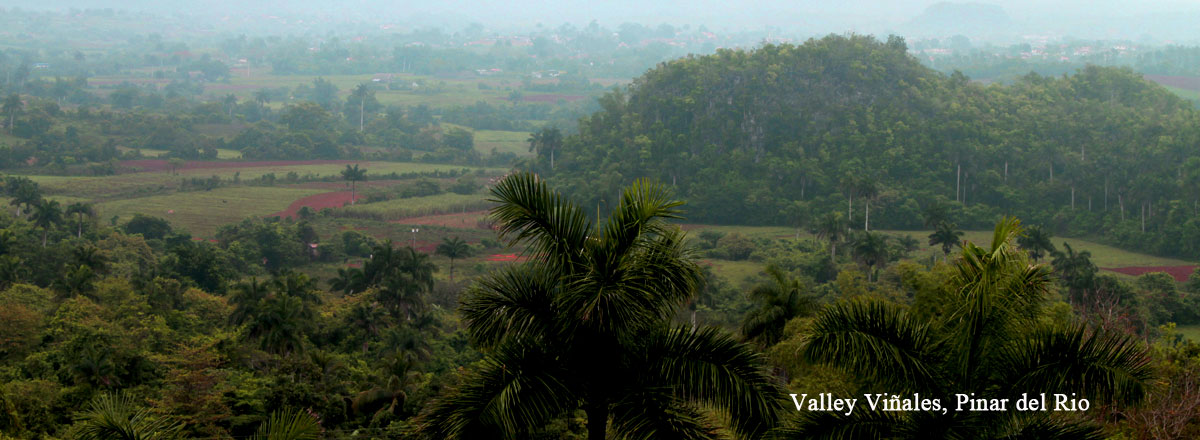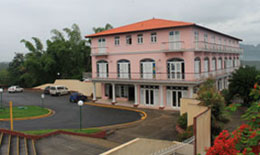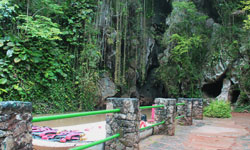Viñales Valley is located in the northern part of the province of Pinar del Rio. It has a territorial extension of 693.77 square kilometres without including an area of 920 hectares belonging to adjacent keys which represents 6 percent of the total province.
The small town of Viñales is found in the Sierra de los Organos Mountains, part of the Guaniguanico chain, in a fertile plain full of rock formations and mountainous area.
The first references that exist on Viñales say that after multiple trespasses of wealth in 1871, the Viñales farm belonged to Don Andres Hernandez Ramos which in 1878 donates two plantations and land for the construction of a town with a typical infrastructure of the time (church, city hall, recreational plaza, school and hospital). On January 1879, Viñales is official declared a town. Since then this municipality has been turning into one of the most prosperous areas of the province.
In Viñales there are 4 special areas: Viñales Valley, Sierra de Viñales, Sierra Ancon and Sierra del Infierno.
Viñales Monumental Heritage is constituted by the Valley and the People, both legally protected and recognized by UNESCO as World Heritage Site. Also as important are the Ceja del Negro Historic Site and the Santo Tomas Gran Caverna. Due to the presence of indigenous paintings the following have been declared local monuments; Cura Cave, Petroglifos Cave and the Garrafon Cave in the Sierra de los Organos.
In these protected areas there are important natural values and they are recognized by its beautiful monumental landscapes with vertical rock formations and carsick sierras, rich flora and fauna and the areas with pine trees. In addition to drains underground rivers, medicinal and mineral waters, small beaches among others. The existence of caves is very common in this area, it has the largest cave system in the whole country, created by the erosion of the rivers. Among the most famous are the Indian Cave which has the San Juan and Santo Tomas rivers go through its interior, the largest of the Antilles with 45 kilometers in length.
Viñales Valley has unique or almost extinct vegetable and animal species. Some 4 kilometers from the town of Viñales you can find the Dos Hermanas rock formation that exhibits in one of its sides the Pre-historic Mural, an enormous painting of 120 meters high and 180 wide by Cuban artist Leovigildo Gonzalez student of Mexican muralist Diego de Rivera representing animals and creatures that lived in the region.
Mural of Prehistory
It is one of the largest fresh openwork planet with 120 meters high and 160 wide. It was created in 1959 by painter and scientist Leovigildo Gonzalez (disciple of the Mexican muralist Diego Rivera) with the help of more than a dozen farmers who volunteered for the risky task leashes parachute to climb to the summit. This mural shows the evolution of life in natural sense in Cuba. It is located on a vertical wall painted on the hillock called Pita, who was cleared to perform this work. The rock was washed and drains were made to avoid it in the future, erosion because of rain. The mural depicts the biogeologic past of the region, considered one of the most ancient lands in the Caribbean. Along with the human figures that evoke the natives of this area of the archipelago, include those of large mammals such as megalocnus rodens (giant bear disappeared) and ammonites, molluscs more than 70 million years old. Ecured-Mural of Prehistory (only Spanish)

Things to do
Places of interest
- ✓ Santo Tomas Gran Caverna
- ✓ Indian Cave
- ✓ Palenque of the Maroons
- ✓ Mural of Prehistory
- ✓ Prehistoric park
Places of interest
- ✓ Palmarito Cave
- ✓ House Veguero
- ✓ Viñales Valley Overlook
- ✓ Botanical Garden
- ✓ Horse ride through the valley
Restaurants
- ✓ Finca Agroecologica El Paraiso
- ✓ 3J Bar de Tapas
- ✓ Balcon del Valle
- ✓ El Olivo
- ✓ Paladar La Cuenca
- ✓ La Casa Verde
Guest house
- ✓ Villa Cristal-1 hab w/bathroom
- ✓ Vista al valle-2 hab w/bathroom
- ✓ Casa Felipa-2 hab w/bathroom
- ✓ Seydi Y Geysi-2 hab w/bathroom
- ✓ Villa Silvia-2 hab w/bathroom





